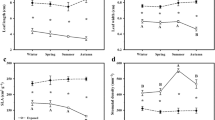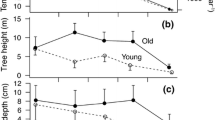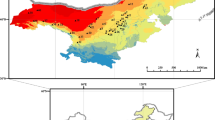Abstract
Coordinated variation has been reported for leaf structure, composition and function, across and within species, and theoretically should occur across populations of a species that span an extensive environmental range. We focused on Hawaiian keystone tree species Metrosideros polymorpha, specifically, 13-year old trees grown (2–4 m tall) in a common garden (approximately 1 ha field with 2–3 m between trees) from seeds collected from 14 populations along an altitude–soil age gradient. We determined the genetic component of relationships among specific leaf area (SLA), the concentrations of nitrogen (N) and pigments (chlorophylls, carotenoids, and anthocyanins), and photosynthetic light-use efficiency. These traits showed strong ecotypic variation; SLA declined 35% with increasing source elevation, and area-based concentrations of N, Chl a + b and Car increased by 50, 109 and 96%, respectively. Concentrations expressed on a mass basis were not well related to source elevation. Pigment ratios expressed covariation that suggested an increased capacity for light harvesting at higher source elevation; Chl/N and Car/Chl increased with source elevation, whereas Chl a/b declined; Chl a/b was higher for populations on younger soil, suggesting optimization for low N supply. Parallel trends were found for the photosynthetic reactions; light-saturated quantum yield of photosystem II (Φ PSII) and electron transport rate (ETR) increased with source elevation. Correlations of the concentrations of photosynthetic pigments, pigment ratios, and photosynthetic function across the ecotypes indicated a stoichiometric coordination of the components of the light-harvesting antennae and reaction centers. The constellation of coordinated morphological, biochemical and physiological properties was expressed in the leaf reflectance and transmittance properties in the visible and near-infrared wavelength region (400–950 nm), providing an integrated metric of leaf status among and between plant phenotypes.



Similar content being viewed by others
References
Abuzar M, Al-Ghunaim I (1997) Spatial disaggregation of spectral data for haze assessment in an arid environment. Int J Remote Sensing 18:1693–1702
Anderson JM, Chow WS, Park YI (1995) The grand design of photosynthesis: acclimation of the photosynthetic apparatus to environmental cues. Photosynth Res 46:129–139
Asner GP, Carlson KM, Martin RE (2005) Substrate and precipitation effects in Hawaiian forest canopies from spaceborne imaging spectroscopy. Remote Sensing Environ 96:497–508
Asner GP, Martin RE, Carlson KM, Rascher U, Vitousek PM (2006) Vegetation–climate interactions among native and invasive species in Hawaiian rainforest. Ecosystems 9:1041–1054
Asner GP, Wessman CA, Archer S (1998) Scale dependence of absorption of photosynthetically active radiation in terrestrial ecosystems. Ecol Appl 8:1003–1021
Baker NR, Ort DR, Harbinson J, Whitmarsh J (2004) Chloroplast to leaf. In: Smith W, Vogelmann TC, Critchley C (eds) Photosynthetic adaptation: chloroplast to landscape, vol 178. Springer, Berlin Heidelberg New York, pp 89–104
Björkman O, Demmig-Adams B (1995) Regulation of photosynthetic light energy capture, conversion, and dissipation in leaves of higher plants. In: Schultze ED, Caldwell MM (eds) Ecophysiology of photosynthesis. Springer, Berlin Heidelberg New York, pp 17–47
Blackburn GA (1998) Quantifying chlorophylls and carotenoids at leaf and canopy scales: an evaluation of some hyperspectral approaches. Remote Sensing Environ 66:273–285
Chalker-Scott L (1999) Environmental significance of anthocyanins in plant stress. Photochem Photobiol 70:1–9
Chapin FS III, Bloom AJ, Field CB, Waring RH (1987) Plant responses to multiple environmental factors. Bioscience 37:49–57
Cordell S, Goldstein G, Mueller-Dombois D, Webb D, Vitousek PM (1998) Physiological and morphological variation in Metrosideros polymorpha, a dominant Hawaiian tree species, along an altitudinal gradient: the role of phenotypic plasticity. Oecologia (Berlin) 113:188–196
Curran PJ (1989) Remote sensing of foliar chemistry. Remote Sensing Environ 30:271–278
Demmig-Adams B, Adams WWI (1996) The role of xanthophyll cycle carotenoids in the protection of photosynthesis. Trends Plant Sci 1:21–26
Dobrowski SZ, Pushnik JC, Zarco-Tejado PJ, Ustin SL (2005) Simple reflectance indices track heat and water stress-induced changes in steady-state chlorophyll fluorescence at the canopy scale. Remote Sensing Environ 97:403–414
Ehleringer JR (1984) Ecology and ecophysiology of leaf pubescence in North American plants. In: Rodriguez E, Healey PL, Mehta I (eds) Biology and chemistry of plant trichomes. Plenum, New York, pp 113–132
Evans JR (1989a) Partitioning of nitrogen between and within leaves grown under different irradiances. Aust J Plant Physiol 16:533–548
Evans JR (1989b) Photosynthesis and nitrogen relationships in leaves of C3 plants. Oecologia 78:9–19
Evans JR, Poorter H (2001) Photosynthetic acclimation of plants to growth irradiance: the relative importance of specific leaf area and nitrogen partitioning in maximizing carbon gain. Plant Cell Environ 24:755–767
Evans JR, Seemann JR (1989) The allocation of protein nitrogen in the photosynthetic apparatus: costs, consequences, and control. In: Briggs WR (ed) Photosynthesis. Allan R. Liss Inc., New York, pp 183–205
Evans JR, Vogelmann TC, Williams WE, Gorton HL (2004) Chloroplast to leaf. In: Smith W, Vogelmann TC, Critchley C (eds) Photosynthetic adaptation: chloroplast to landscape, vol 178. Springer, Berlin Heidelberg New York, pp 15–41
Farquhar GD, von Caemmerer S (1982) Modeling of photosynthetic response to environmental conditions. In: Lange OL, Nobel PS, Osmond CB, Ziegler H (eds) Encyclopedia of plant physiology (NS), vol 12B. Springer, Berlin Heidelberg New York, pp 549–587
Field C, Mooney HA (1986) The photosynthesis–nitrogen relationship in wild plants. In: Givnish TJ (ed) On the economy of plant form and function. Cambridge University Press, Cambridge, pp 25–55
Gamon JA, Field CB, Bilger W, Björkman A, Fredeen AL, Peñuelas J (1990) Remote sensing of the xanthophyll cycle and chlorophyll fluorescence in sunflower leaves and canopies. Oecologia 85:1–7
Gamon JA, Serrano L, Surfus JS (1997) The photochemical reflectance index: an optical indicator of photosynthetic radiation use efficiency across species, functional types, and nutrient levels. Oecologia (Berlin) 112:492–501
Gamon JA, Surfus JS (1999) Assessing leaf pigment content and activity with a reflectometer. New Phytol 143:105–117
Gates DM, Keegan HJ, Schleter JC, Weidner VR (1965) Spectral properties of plants. Appl Opt 4:11–20
Geeske J, Aplet G, Vitousek PM (1994) Leaf morphology along environmental gradients in Hawaiian Metrosideros polymorpha. Biotropica 26:17–22
Genty B, Briantais JM, Baker NR (1989) The relationship between quantum yield of photosynthetic electron transport and quenching of chlorophyll fluorescence. Biochim Biophys Acta 990:87–92
Gitelson AA, Gritz Y, Merzlyak MN (2003) Relationships between leaf chlorophyll content and spectral reflectance and algorithms for non-destructive chlorophyll assessment in higher plant leaves. J Plant Physiol 160:271–282
Gitelson AA, Merzlyak MN, Chivkunova OB (2001) Optical properties and nondestructive estimation of anthocyanin content in plant leaves. Photochem Photobiol 74:38–45
Gitelson AA, Zur Y, Chivkunova OB, Merzlyak MN (2002) Assessing carotenoid content in plant leaves with reflectance spectroscopy. Photochem Photobiol 75:272–281
Givnish TJ, Montgomery RA, Goldstein G (2004) Adaptive radiation of photosynthetic physiology in the Hawaiian lobeliads: light regimes, static light responses, and whole-plant compensation points. Am J Bot 91:228–246
Harrington RA, Fownes JH, Vitousek PM (2001) Production and resource use efficiencies in N- and P-limited topical forests: a comparison of responses to long-term fertilization. Ecosystems 4:646–657
Hikosaka K (2004) Interspecific difference in the photosynthesis–nitrogen relationship: patterns, physiological causes, and ecological importance. J Plant Res 117:481–494
Hikosaka K, Terashima I (1996) Nitrogen partitioning among photosynthetic components and its consequence in sun and shade plants. Funct Ecol 10:335–344
Jacquemoud S, Ustin SL, Verdebout J, Schmuck G, Andreoli G, Hosgood B (1996) Estimating leaf biochemistry using the PROSPECT leaf optical properties model. Remote Sensing Environ 56:194–202
Karabourniotis G, Bornman JF (1999) Penetration of UV-A and UV-B and blue light through the leaf trichome layers of two xeromophic plants, olive and oak, measured by optical fibre probes. Physiol Plant 105:655–661
Kitajima K, Hogan KP (2003) Increases of chlorophyll a/b ratios during acclimation of tropical woody seedlings to nitrogen limitation and high light. Plant Cell Environ 26:857–865
Kitayama K, Mueller-Dombois D (1995) Vegetation changes along gradients of long-term soil development in the Hawaiian montane rainforest zone. Vegetatio 120:1–20
Kitayama K, Pattison R, Cordell S, Webb D, Mueller-Dombois D (1997) Ecological and genetic implications of foliar polymorphism in Metrosideros polymorpha Guad. (Myrtaceae) in a habitat matrix on Mauna Loa, Hawaii. Ann Bot 80:491–497
le Maire G, Francois C, Dufrene E (2004) Towards universal broad leaf chlorophyll indices using PROSPECT simulated database and hyperspectral reflectance measurements. Remote Sensing Environ 89:1–28
Lichtenthaler HK, Buschmann C (2001) Chlorophylls and carotenoids: measurement and characterization by UV–VIS spectroscopy. In: Current protocols in food analytical chemistry. Wiley, New York, pp F4.3.1–F4.3.8
Markwell J, Osterman JC, Mitchell JL (1995) Calibration of the minolta SPAD-502 leaf chlorophyll meter. Photosynth Res 46:467–472
Marquard RD, Tipton JL (1987) Relationship between extractable chlorophyll and an in situ method to estimate leaf greenness. Hortscience 22:1327–1327
Merzlyak MN, Solovchenko AE, Gitelson AA (2003) Reflectance spectral features and non-destructive estimation of chlorophyll, carotenoid and anthocyanin content in apple fruit. Postharvest Biol Technol 27:197–211
Mueller-Dombois D (1987) Forest dynamics in Hawaii. Trends Ecol Evol 2:216–220
Nichol C, Rascher U, Matsubara S, Osmond B (2006) Assessing photosynthetic efficiency in an experimental mangrove canopy using remote sensing and chlorophyll fluorescence. Trees 20:9–15
Niinemets U (2001) Global-scale climatic controls of leaf dry mass per area, density, and thickness in trees and shrubs. Ecology 82:453–469
Niinemets U, Kull O (2001) Sensitivity of photosynthetic electron transport to photoinhibition in a temperate deciduous forest canopy: photosystem II openness, non-radiative energy dissipation and excess irradiance under field conditions. Tree Physiol 21:899–914
Niinemets U, Sack L (2006) Structural determinants of leaf light harvesting capacity and photosynthetic potentials. Prog Bot 67:385–419
Penuelas J, Filella I, Gamon JA (1995) Assessment of photosynthetic radiation-use efficiency with spectral reflectance. New Phytol 131:291–296
Poorter H, Evans JR (1998) Photosynthetic nitrogen-use efficiency of species that differ inherently in specific leaf area. Oecologia (Berlin) 116:26–37
Raich JW, Russell AE, Vitousek PM (1997) Primary productivity and ecosystem development along an elevational gradient on Mauna Loa, Hawaii. Ecology 78:707–722
Reich PB, Walters MB (1994) Photosynthesis–nitrogen relations in Amazonian tree species. Oecologia 97:73–81
Reich PB, Walters MB, Ellsworth DS (1997) From tropics to tundra: global convergence in plant functioning. Proc Natl Acad Sci USA 94:13730–13734
Richardson AD, Dulgan SP, Berlyn GP (2002) An evaluation of noninvasive methods to estimate foliar chlorophyll content. New Phytol 153:185–194
Schreiber U, Bilger W (1993) Progress in chlorophyll fluorescence research: major developments during the past years in retrospect. Prog Bot 54:151–157
Sims DA, Gamon JA (2002) Relationships between leaf pigment content and spectral reflectance across a wide range of species, leaf structures and developmental stages. Remote Sensing Environ 81:337–354
Takashima T, Hikosaka K, Hirose T (2004) Photosynthesis or persistence: nitrogen allocation in leaves of evergreen and deciduous Quercus species. Plant Cell Environ 27:1047–1054
Terashima I, Evans JR (1988) Effects of light and nitrogen nutrition on the organization of the photosynthetic apparatus in spinach. Plant Cell Physiol 29:143–155
Terashima I, Hikosaka K (1995) Comparative ecophysiology of leaf and canopy photosynthesis. Plant Cell Environ 18:1111–1129
Ustin SL, Roberts DA, Gamon JA, Asner GP, Green RO (2004) Using imaging spectroscopy to study ecosystem processes and properties. Bioscience 54:523–534
Vitousek PM (2004) Nutrient cycling and limitation: Hawai’i as a model system. Princeton University Press, Princeton, NJ
Vitousek PM, Turner DR, Kitayama K (1995) Foliar nutrients during long-term soil development in Hawaiian montane rain forest. Ecology 76:712–720
Walters RG (2005) Towards an understanding of photosynthetic acclimation. J Exp Bot 56:435–447
Warren CR, Adams MA (2004) What determines rates of photosynthesis per unit nitrogen in Eucalyptus seedlings? Funct Plant Biol 31:1169–1178
Wright IJ et al. (2005) Assessing the generality of global leaf trait relationships. New Phytol 166:485–496
Wright IJ et al. (2004) The worldwide leaf economics spectrum. Nature 428:821–827
Young A, Britton G (1990) Carotenoids and stress. In: Alscher RG, Cumming JR (eds) Stress responses in plants: adaptation and acclimation mechanisms. Wiley-Liss, New York, pp 87–112
Zar JH (1999) Biostatistical analysis, 4th edn. Prentice Hall, Upper Saddle River, NJ
Acknowledgements
We thank K. Lo and C. Lunch for assistance in the field, D. Turner for assistance with leaf nitrogen determinations, and J. Berry for his important insights and interpretations. This work was supported by the National Science Foundation (DEB-0136957 and IOB-0546784), NASA Terrestrial Ecology and Biodiversity Program Grant (NNG-06-GI-87G), and The Carnegie Institution.
Author information
Authors and Affiliations
Corresponding author
Additional information
Communicated by Robert Pearcy.
Rights and permissions
About this article
Cite this article
Martin, R.E., Asner, G.P. & Sack, L. Genetic variation in leaf pigment, optical and photosynthetic function among diverse phenotypes of Metrosideros polymorpha grown in a common garden. Oecologia 151, 387–400 (2007). https://doi.org/10.1007/s00442-006-0604-z
Received:
Accepted:
Published:
Issue Date:
DOI: https://doi.org/10.1007/s00442-006-0604-z




